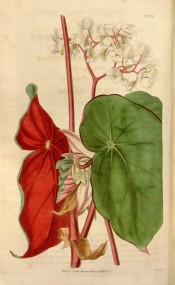Begonia sanguinea Raddi
Frost-tender, shrub-like begonia with red stems, medium, oval, shiny deep green leaves, red beneath, and clusters of up to 30 white flowers, suspended from the stems, from winter to spring. To 1.2m. A good hanging basket subject. [RHSD, Hortus, Krempin].
Horticultural & Botanical History
‘Stems about three feet in height, of a dull crimson colour, and quite smooth. Leaves oblique, about six inches in length, dark green above, bright crimson beneath, and smooth on both sides. Flowers almost white, produced in clusters of from twenty to thirty blooms.’ [FC p.273/1846]. Introduced to Britain in 1820 according to Krempin and 1829 according to Paxton’s Dictionary. ‘This very striking species is a native of Brazil, from whence it has been introduced into this country in 1832. It has bloomed in the Edinburgh Botanic Garden.’ [FC p.284/1836]. Curtis’s Botanical Magazine agrees with this later date, giving its source as Berlin. ‘This plant, more remarkable for the colour and texture of its leaves than elegant in its form, was raised at the Botanic Garden of Berlin, from seed transmitted by M. Sello, from Brazil, in 1823. It flowers in the stove in April.’ [BM t.3520/1836].
History at Camden Park
Listed in the 1850 and 1857 catalogues [H.23/1850]. Obtained from Kew Gardens. It was included among desiderata in a letter to Sir William Hooker on 11th February 1848 and was marked ‘arrived’ on Macarthur’s copy [MP A2933-1, p.165]. It was also requested of Loddiges’ nursery on 13th February, 1848 [MP A2933-1, p.172].
Notes
Published Jun 20, 2009 - 04:20 PM | Last updated Jul 14, 2010 - 04:54 PM
| Family | Begoniaceae |
|---|---|
| Category | |
| Region of origin | Brazil |
| Synonyms | |
| Common Name | |
| Name in the Camden Park Record | Begonia sanguinea |
| Confidence level | high |
